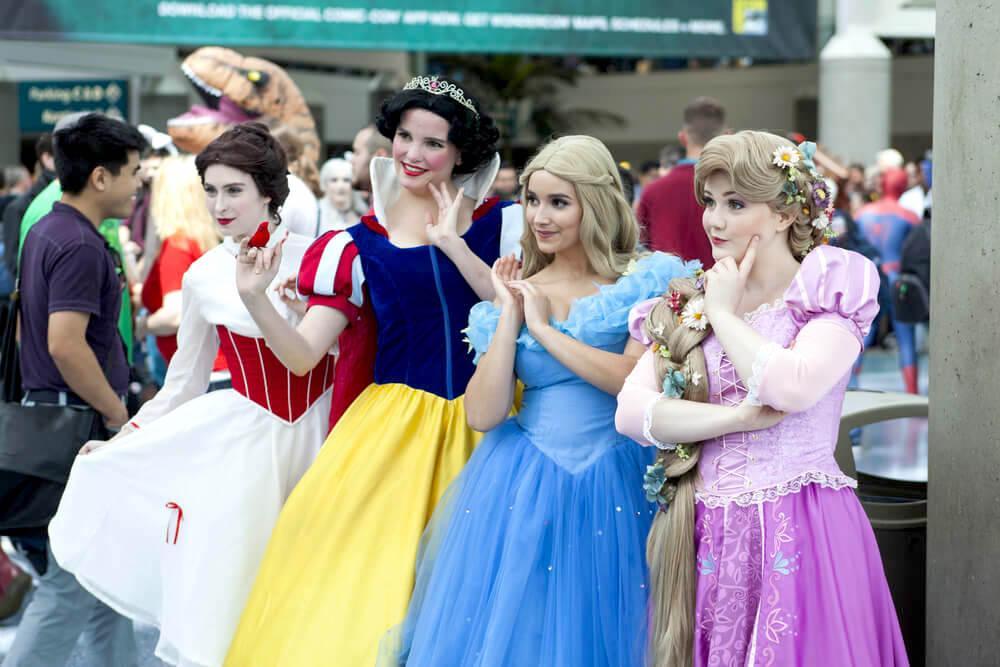Can you imagine a world in which there were no Disney Princesses? There would be no big sparkly dresses, wands and tiaras for little girls to dress up in, no books and movies that them to places where dreams come true and happy endings are required, no princess themed bedrooms, parties, or accessories with decorated with images of long-lashed gloved belles of the ball on them. Would the world be a better place?
That seems to be the big debate. While it’s no doubt the Disney Princesses are lovely and children, specifically girls, never seem to tire of them, there is also little uncertainty about the fact that they are very stereotypically female. They have idealized body types, don’t seem to have much career ambition and depend on princes to rescue them. However, that doesn’t mean that they don’t also have attributes that also make them wonderful role models.

These days, a lot of the princesses are waking up and smelling the coffee. These ladies have had a long history; they’ve been through the “burn your bra” movement and “Me Too” campaign, and they have a lot more open-mindedness to show for it. Do we really have to banish them from our daughter’s bedrooms just yet?
There are some older Princesses who still haven’t lost their magic and others who may actually still be casting some new spells of their own. Here are a few Disney Princesses who are serving as positive role models for children today.
Cinderella

Cinderella is sort was the one from whom we coined the expression ”Cinderella Story,” which means she pretty much set the standard for all the princesses, so she’s a pretty good princess to start with.
If you’ll remember, Cinderella was that typical princess; rich dad marries a less fortunate woman with two daughters, who somehow think that gives them the license to pick on their more attractive and privileged stepsister ( as the illustrators of the story seem to have no compunction about pointing out). The stepsisters and mother assign her chores around the house, the main one of which is cleaning out the fireplace: hence the name Cinderella.
Enter a fairy godmother who comes to Cinderella bringing tales of a ball that the young princess will attend where she will meet a handsome Prince and make it all better. This is where we get the message about men wielding the power that Cinderella and her fellow princesses are so often criticized for. Also, note that the stepmother relies on full financial support from Cinderella’s dad.
However, despite this, there are many aspects of “Cinderella” that make her a positive role model for little girls. The mice in the story who enable Cinderella to get to the ball act like young children, and are shown as equally, if not more powerful than the prince when it comes to helping to change Cinderella’s life. The mice link themselves back to Cinderella, taking cues from her optimistic disposition and impressive display of energy in a seemingly hopeless situation. Although Cinderella does rely on a handsome prince to rescue her in the end, she also does a good job of rescuing herself and setting a positive example for little girls everywhere.
Snow White

While Cinderella was having a ball, Snow White was getting up to her own little adventures out there in the woods with the Seven Dwarves. If you’ll recall, Snow White was the princess whose wicked jealous stepmother sent a huntsman after her to kill her because of her extreme beauty? You might also remember that, once the huntsman sets eyes on her, he realizes he cannot kill such a lovely young lady and allows her to run into the forest where she meets the Seven Dwarves and eventually marries a prince.
Sound like your typical disempowered woman relying on a man to change her bleak destiny? Not so fast! Let’s think about this a minute. Snow White may be waiting for Mr. Right/White, but she’s hardly sitting on her high haunches while she’s doing it. No way! She’s being industrious, working with those seven dwarves and taking care of them. So maybe some of her duties included cleaning the cottage( remember, it was the 1930’s back then), she always makes the best of it, finding the silver lining in the clouds every time things look tough and serving as a role model for her brood.
Pocahontas

So how does a tough free-spirited brave Native American princess find herself giving up on her dreams of romance and adventure and ending up stuck at home taking care of her family? That’s the question that many feminists ask of Pocahontas.
Pocohantas is a free-spirited girl in touch with her environment. She seems connected to animals on an almost on an almost spiritual level. Her movements are deerlike, and she is often seen in the company of Meeko, her pet raccoon, and Flit, her hummingbird.
Her relationship with John Smith shows her to be candid and straightforward. When he calls her people “savages” she calmly rebuffs him with logic, pointing out that to her people, he would appear to be the savage due to his lack of knowledge and knowledge of the land. She shows herself to be fiercely independent, never cow-towing to the male ego. She’s a peaceful negotiator between the colonists and her tribe, representing harmony, unity, and tranquility.
So how does she end up in North America living up to her Dad’s expectations? There it is again, the million dollar question. Has she just decided to give up on her passion and settle into the stereotypic role, or is the message actually an empowering one? Perhaps Pocohantas is willingly choosing her people and her territory over a life that may not the one she was meant for. Either way, Pocahontas does make a selfless and logical decision that will most likely benefit the majority and can be seen as a role model for that alone.
Mulan

If there is an argument over whether or not Pocohantas made the more empowering choice at the end of her tale, there are no two ways about it in Mulan. This girl is badass.
No prince here, Mulan doesn’t need one. She’s a young woman in China who not only doesn’t fit the traditional mold of the petite well behaved Chinese young lady, she out and out destroys it. She consistently disappoints her family when they urge her to conform to stereotypes, she’s outspoken, ambitious, and masculine, and she even threatens the reputation of her family with her dishonorable behavior.
Furthermore, she cross-dresses ( What? A princess without a gown?) As the film progresses she goes to fight in the emperor’s army in place of her disabled father, quickly becoming an essential member of the military and saving the day.
A little too masculine you say? Does Mulan go so far into celebrating Mulan’s masculine traits that it belittles her feminine ones? When Mulan is celebrated for her triumph, she does so dressing and acting as a traditional female. In doing so, she sends a valuable message to all women worldwide. She shows herself to be a strong and independent woman who defies the odds, pushes the envelope and saves the empire while she does it.
Brave (Merida)

Forget about changing the toad into a prince here – in “Brave” there’s no prince and the mom turns into a bear. We sure have come a long way from Cinderella with this one, and the bear is only the beginning.
“Brave” is the story of Merida, an opinionated young princess who would rather shoot an arrow than clean the house. When she gets sick of hearing it from her mom, she hooks up with a witch who gives Merida a tart. Her mom eats it and “Roar,” she’s a bear- albeit a very civilized one. At first, she still attempts to wear her tiara while she’s living in the woods, but as she gets used to her condition, she gets more in touch with her wild side.
The irony here is that the mom here turns into the animal that most closely resembles Merida. Merida is stubborn, and not afraid to advocate for herself. She often states that she will marry only for love and not traditional reasons. She’s headstrong and willing to go up against men in their political positions.
Mom, (the Queen) on the other hand is the picture of domestication. She manages to” tame” her unruly children is known for her sewing skills and ability to maintain a well-run household. As queen, she is expected to present a standard of womanhood, and motherhood not only to her family but to her country as well.
So what happens when she turns into a bear? She becomes Merida’s equal and the two begin to see things on an eye to eye level. Merida starts to appreciate the sacrifices her mother has made for her and her mom can celebrate her daughter’s free, spunky spirit.
Frozen (Elsa)

Elsa may have “let go” of her inhibitions in the movie “Frozen,” but it seems fans are still having trouble of the movie and the song. Maybe that’s because “Frozen” sent such a positive message to girls about what they’re capable of.
The story opens with Elsa, future queen, and possessor of wild, wonderful wintery powers – powers that have the potential to be harmful when used without extreme caution. When her abilities end up accidentally causing harm her little sister, Anna, Elsa’s parents lock the princess up. This leaves Elsa suffering emotional damage and Anna wondering why her big sister has been taken from her. Anna finds herself desiring nothing more than a reunion with Elsa, and spends much of her time attempting to do so. On the night of Elsa’s coronation, her powers are revealed and she retreats to her own icy kingdom in fear of rejection. “Frozen,” tells the story of Anna’s journey to save her sister and their kingdom.
So let’s take a minute to break this down here. First, we have a theme of embracing differences. Elsa has always seen her powers as a cause for shame. Her parents have brought her up to believe they are something to be feared and concealed, rather than celebrated and as Queen of Arendelle, she is initially afraid to use them. The pain and isolation she shows at the beginning of the story show how damaging the effects of oppressing gifts can be.
There is also a theme of the strength of women. The two sisters eventually save one another with little assistance from outside forces. When Anna’s heart is accidentally frozen by Elsa, Kristoff learns that only a true act of love will save her. He naturally assumes this will be a kiss from Hans, and takes her to him. In the end, it is Anna’s self-sacrifice to save her sister’s life that serves to save herself.
Belle

When we first see Belle, she’s headed to town with a book in her basket, ready to exchange it for another at the local booksellers. When the bookseller tells her she can keep it, she responds with the same enthusiasm one would if they had won the lottery. An overreaction? Perhaps, but that’s just the way Belle rolls. To her, books are priceless treasures and wonders to behold.
Not so much when it comes to her opinion of boys, however. While other girls swoon over Gaston at school, she sees him for the arrogant self-centered fool that he is. That’s not the only way Belle resists the status quo, though. She also stands up for her quirky dad and his weird inventions and sacrifices her freedom for him at the end. Plus we know how she’s able to see right past Beast’s more beastly attributes, inspiring him to become the gentleman he becomes.
Belle also shows her open-mindedness when she finds ease in the enchanted environment of the beast’s castle. She accepts it, rather than approaching it with suspicion of fear. The fact that the housekeeper is a teapot doesn’t bother a bit. Belle encourages us to see good in everyone and inspires us to become better versions of ourselves.
*Featured image credit:Lauren Elisabeth / Shutterstock.com






Leave A Comment